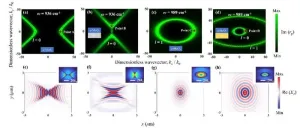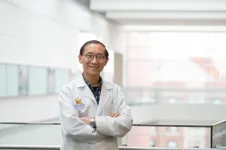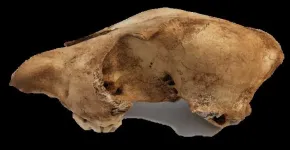A new publication from Opto-Electronic Advances; DOI 10.29026/oes.2024.240002 , discusses boosting UV Light Absorption in 2D Semiconductor with quantum dot hybrids for enhanced light emission.
Two-dimensional (2D) transition metal dichalcogenides (TMDs) have emerged as a promising class of materials due to their remarkable properties. These materials, such as monolayer tungsten disulfide (1L-WS2), are just a few atoms thick, yet they possess intriguing electronic and optical characteristics that make them highly attractive for various applications, from flexible electronics to optoelectronic devices. However, despite their potential, 2D TMDs have their limitations. One significant drawback is their weak light absorption and poor light emission properties, especially in the ultraviolet (UV) range. This weakness restricts their performance and utility in applications requiring UV light interaction, such as UV light-emitting diodes (LEDs), sensors, and photodetectors. Overcoming this limitation is essential to fully unlock the potential of these materials in UV-related technologies. Quantum dots (QDs) offer a promising solution to enhance the light-absorbing and light-emitting capabilities of 2D TMDs. QDs are tiny semiconductor particles with unique optical and electronic properties, including size-dependent energy levels. When integrated with 2D materials, QDs can absorb a wide range of light energies, including UV light, and efficiently convert them into visible light. This property makes them ideal candidates for improving the performance of 2D TMDs in UV optoelectronic applications. In this study, we aimed to enhance the UV light absorption and emission properties of monolayer tungsten disulfide (1L-WS2) by incorporating quantum dots derived from 2D materials (2D/QD hybrids). Specifically, we focused on two types of quantum dots: titanium nitride MXene quantum dots (Ti2N MQDs) and graphitic carbon nitride quantum dots (GCNQDs). These quantum dots were selected based on their strong UV absorption capabilities and environmentally friendly nature, making them suitable candidates for integration with 1L-WS2 UV light harvesting. To create the hybrid materials, we synthesized Ti2N MQDs and GCNQDs using specific chemical processes, ensuring their uniform size and dispersity. We then prepared 1L-WS2 flakes from bulk WS2 and deposited them on top of the dispersed quantum dots. This integration process aimed to enable efficient energy transfer from the quantum dots to the 1L-WS2 layer, thereby enhancing its UV light absorption and emission properties. Upon investigating the optical properties of the hybrid materials, we observed a significant enhancement in the UV light absorption and emission of 1L-WS2 when combined with Ti2N MQDs or GCNQDs. Under UV light excitation at a wavelength of 300 nm, the hybrid materials exhibited a remarkable increase in light emission intensity compared to pristine 1L-WS2 flakes. Specifically, 1L-WS2 combined with Ti2N MQDs showed a maximum light emission enhancement by 15 times, while those with GCNQDs exhibited an 11-fold increase in light emission. The enhancement in PL intensity can be attributed to the efficient energy transfer from the quantum dots to the 1L-WS2 layer. When excited by UV light, the quantum dots absorb the incoming photons and then transfer the absorbed energy to the 1L-WS2, thereby promoting the emission of visible light. This process effectively overcomes the inherent limitations of 1L-WS2 in UV light absorption and emission, leading to a substantial improvement in its optoelectronic performance. In summary, our study demonstrates a novel approach to enhance the UV light absorption and emission properties of 1L-WS2 through hybridization with Ti2N MQDs and GCNQDs. By integrating these quantum dots with 1L-WS2, we achieved a significant enhancement in light emission under UV light excitation, paving the way for the development of advanced UV optoelectronic devices and other applications. Furthermore, the environmentally friendly nature of the quantum dots used in this study adds an additional advantage for their widespread utilization in various fields, including biomedical applications.
This work represents a significant advancement in the field of optoelectronics and materials science, particularly in the domain of two-dimensional (2D) materials and their hybrid structures with quantum dots (QD).
Addressing Limitations of 2D Materials: The study focuses on overcoming a significant limitation of monolayer transition metal dichalcogenides (TMDs), such as molybdenum disulfide and tungsten disulfide. Despite their promising optical properties, these materials suffer from low photoluminescence quantum yield (PLQY), especially under ultraviolet (UV) illumination. This work addresses this issue by introducing a novel hybridization approach using quantum dots.
Innovative Hybrid Structure: By incorporating titanium nitride (Ti2N) and graphitic carbon nitride (GCN) quantum dots into monolayer TMDs, the researchers create a unique 0D/2D hybrid structure. These quantum dots possess efficient UV absorption capabilities, which complement the optical properties of the TMDs.
Enhanced Photoluminescence: The key finding of the study is a significant enhancement in the photoluminescence (PL) emission of monolayer TMDs under UV illumination when hybridized with Ti2N and GCN quantum dots. This enhancement, up to 15 times, opens up new possibilities for utilizing these materials in UV optoelectronic devices and fluorescence-sensing probes.
Insights into Energy Transfer Mechanisms: Through a comprehensive analysis involving time-resolved photoluminescence (TRPL), Raman spectroscopy, and PL analysis, the researchers gain insights into the energy transfer (ET) mechanisms between the quantum dots and the monolayer TMDs. This deeper understanding of the ET process contributes to the fundamental knowledge of light-matter interactions in hybrid materials.
Potential Applications: The findings of this study have implications for various applications, including optoelectronics, photocatalysis, supercapacitors, photovoltaics, biosensors, and energy storage. The enhanced UV response of monolayer TMDs opens up avenues for the development of next-generation devices with superior light-harvesting capabilities.
Environmental Considerations: The use of environmentally friendly quantum dots, such as Ti2N and GCN, underscores the potential of these hybrid materials for biomedical applications and other environmentally sensitive technologies.
In summary, this work represents a significant contribution to the field by addressing fundamental limitations of 2D materials and demonstrating the potential of hybrid structures for enhancing their optical properties. The insights gained from this study pave the way for the development of novel optoelectronic devices and fluorescence-sensing technologies with enhanced UV responsiveness and environmental sustainability.
Keywords: anisotropic phonon polaritons / forbidden direction / substrate with a negative permittivity / near-field energy transport
# # # # # #
Prof. Jeongyong Kim’s group, part of the laboratory for Quantum Optical Semiconductors, is a pioneering force within Sungkyunkwan University's Department of Energy Science, dedicated to unravelling the intricacies of exciton physics in quantum semiconductors. The laboratory boasts state-of-the-art equipment, including a near-field scanning optical microscope with a remarkable resolution of less than 100 nm, a macro-PL measurement system capable of freely choosing the emission and detection wavelengths and an innovative, lab-made high-resolution confocal microscope, complete with a CCD camera, spectrometer and variable temperature- and magnetic field- sample chamber cooled with closed-cycle refrigerator down to 3K. Time-resolved PL can be combined with confocal microscope systems to provide pico second dynamics of excitons and charge carriers in quantum semiconductors. This versatile confocal microscope system stands as a testament to the group's adaptability, readily customizable for a myriad of research objectives, from low-temperature studies to magnetic field effects and beyond, including epifluorescence imaging and valley investigations.
Recently, the research group has pushed the boundaries of materials science by delving into the synthesis of quantum dots derived from MXene and the fabrication of twisted bilayers exhibiting Moiré patterns, all in the pursuit of understanding their unique exciton properties. This expansion of their material repertoire underscores their relentless pursuit of knowledge and innovation.
Prof. Jeongyong Kim's group of multinational talent, is comprised of 10 dedicated lab members, including 2 research fellows and 7 students hailing from diverse research backgrounds, cultures, and ethics. Together, they form a collaborative ecosystem driven by a shared passion for discovery and a relentless commitment to excellence. Under the visionary leadership of Prof. Jeongyong Kim, the group has made significant contributions to the scientific community, with publications in prestigious journals such as Nature Communication, ACS Nano, Advanced Optical Materials, and Opto-electronic Advances, among others.
Beyond their groundbreaking research endeavours, the group actively engages in educational initiatives, collaborating with other universities in and outside of Korea through workshops and participating in international conferences, all with the aim of nurturing the next generation of scientific trailblazers. Through their collective efforts, Prof. Jeongyong Kim's group continues to shape the forefront of quantum optics and semiconductor research, paving the way for transformative advancements in science and technology.
# # # # # #
Opto-Electronic Science (OES) is a peer-reviewed, open access, interdisciplinary and international journal published by The Institute of Optics and Electronics, Chinese Academy of Sciences as a sister journal of Opto-Electronic Advances (OEA, IF=9.682). OES is dedicated to providing a professional platform to promote academic exchange and accelerate innovation. OES publishes articles, reviews, and letters of the fundamental breakthroughs in basic science of optics and optoelectronics.
# # # # # #
More information: https://www.oejournal.org/oes
Editorial Board: https://www.oejournal.org/oes/editorialboard/list
OES is available on OE journals (https://www.oejournal.org/oes/archive)
Submission of OES may be made using ScholarOne (https://mc03.manuscriptcentral.com/oes)
CN 51-1800/O4
ISSN 2097-0382
Contact Us: oes@ioe.ac.cn
Twitter: @OptoElectronAdv (https://twitter.com/OptoElectronAdv?lang=en)
WeChat: OE_Journal
# # # # # #
Chen S, Wu XH, Fu CJ. Active tuning of anisotropic phonon polaritons in natural van der Waals crystals with negative permittivity substrates and its application in energy transport. Opto-Electron Sci 3, 240002 (2024). doi: 10.29026/oes.2024.240002
END





